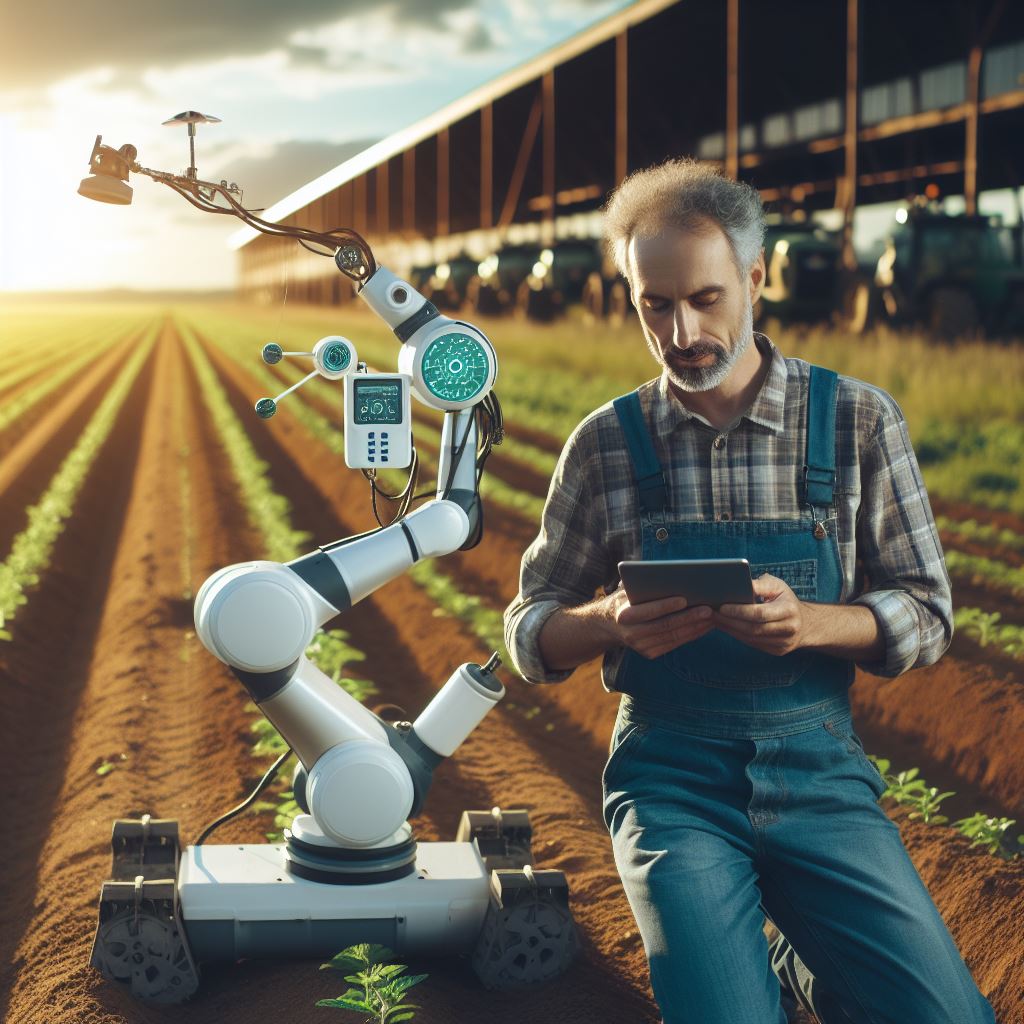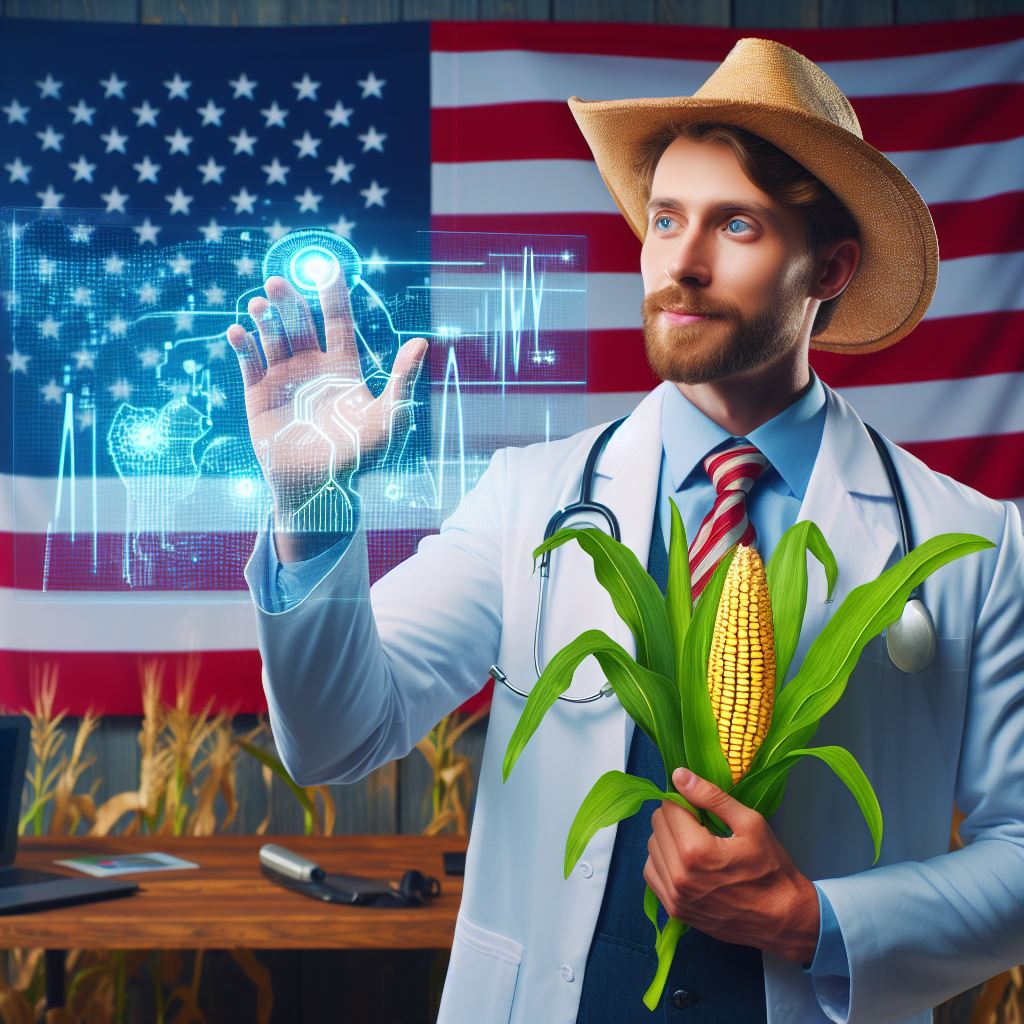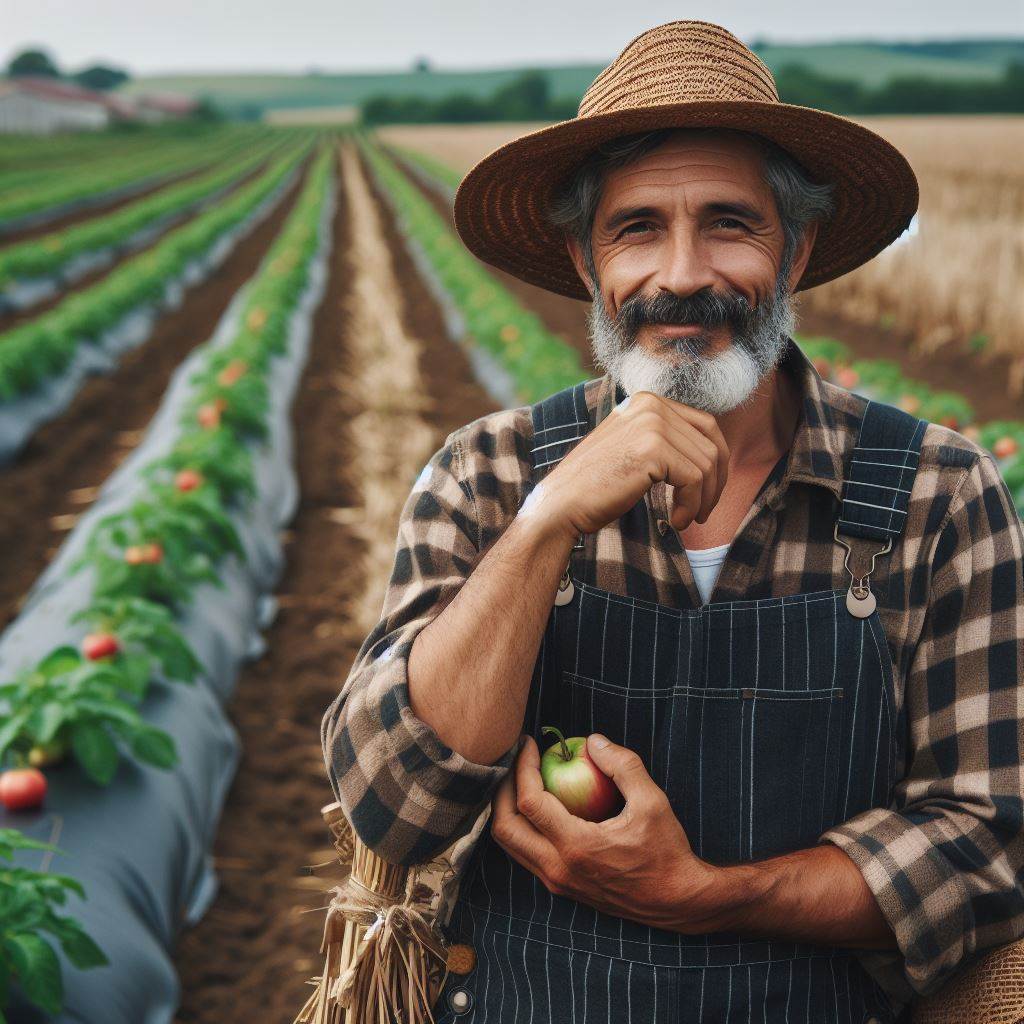Introduction
A. Definition and importance of robotics in agriculture
In agriculture, robotics refers to the use of automated machines for various tasks.
It is important because it improves efficiency and reduces labor costs.
Robotics in agriculture has been steadily developing and gaining adoption over the years.
The purpose of this blog post is to provide an overview of how robotics in agriculture is expected to evolve by 2024.
B. Brief overview of the development and adoption of robotics in agriculture
The adoption of robotics in agriculture has been driven by several factors.
One factor is the increasing need for precision and accuracy in farming practices.
Robots can perform tasks such as planting, watering, and harvesting with greater precision than human laborers.
Another factor is the labor shortage in the agricultural industry.
With robots, farmers can ensure that tasks are completed efficiently, even if there is a shortage of human workers.
C. Purpose of the blog post
By 2024, it is expected that robotics in agriculture will become even more advanced and widely adopted.
Robots will be able to perform a wider range of tasks, including pest control and monitoring crop health.
They will also become more autonomous, able to operate without human supervision.
This will further increase efficiency and reduce the need for human labor.
Basically, the use of robotics in agriculture is revolutionizing the industry.
It offers numerous benefits, such as increased efficiency, reduced labor costs, and improved precision.
Transform Your Agribusiness
Unlock your farm's potential with expert advice tailored to your needs. Get actionable steps that drive real results.
Get StartedAs the technology continues to advance, robotics in agriculture will continue to play a vital role in the future of farming.
Read: Automation’s Role in Modern Agriculture
Current State of Robotics in Agriculture
A. Different types of robots utilized in farming
Robots have become increasingly popular in the agriculture industry due to their numerous advantages.
Drones, for example, are used for crop monitoring, pest management, and even spraying pesticides.
Autonomous tractors have revolutionized farming by autonomously performing tasks such as plowing, sowing, and harvesting.
Robotic harvesters are designed to efficiently and accurately harvest crops, reducing labor costs and minimizing waste.
B. Examples of successful implementation and impact on farming operations
1. Precision agriculture and increased crop yield
One successful implementation of robotics in agriculture is precision agriculture.
By using drones and sensors, farmers can gather data about soil, moisture levels, and crop health, enabling them to make informed decisions and optimize crop yield.
This not only increases productivity but also reduces waste and input usage.
2. Labor shortage solutions and reduced production costs
Another benefit of robotics in agriculture is addressing labor shortages.
Robots can perform various tasks, such as picking produce or weeding fields, reducing the need for human labor.
This is particularly important as the agriculture industry faces a shortage of workers, especially in developed countries.
By using robots, farmers can maintain production levels while reducing labor costs.
3. Environmental benefits and sustainable practices
In addition to increasing productivity and solving labor shortages, robotics in agriculture also brings environmental benefits.
For instance, autonomous tractors can use GPS technology to optimize crop planting and minimize fuel and fertilizer usage.
This leads to reduced emissions and a more sustainable approach to farming.
Robots can also identify and target specific areas for pesticide application, minimizing ecological impact and improving the overall health of the ecosystem.
Essentially, the current state of robotics in agriculture is promising.
The use of drones, autonomous tractors, and robotic harvesters has revolutionized farming operations.
Successful implementations have resulted in increased crop yield through precision agriculture, reduced production costs through labor shortage solutions, and improved sustainability through environmental benefits.
As technology continues to advance, the impact of robotics in agriculture is expected to further transform the industry and contribute to a more efficient and sustainable farming future.
Read: Agri Robots: The Field’s New Friends
Emerging Trends and Advancements in Agricultural Robotics
A. Integration of artificial intelligence and machine learning
These emerging trends and advancements in agricultural robotics are revolutionizing the way farming is conducted.
The integration of artificial intelligence and machine learning in robots has significantly improved their decision-making abilities.
Showcase Your Farming Business
Publish your professional farming services profile on our blog for a one-time fee of $200 and reach a dedicated audience of farmers and agribusiness owners.
Publish Your ProfileBy analyzing data from various sensors, robots can identify and respond to different farming conditions, optimizing resource allocation and improving productivity.
Furthermore, the adaptive and autonomous behavior of robots allows them to continuously learn from their surroundings.
They can adapt their movements and actions based on real-time data, resulting in more efficient and effective farm operations.
For example, a robot equipped with machine learning algorithms can adjust its harvesting technique based on the ripeness of individual crops, reducing waste and ensuring higher yields.
B. Expansion of robotics beyond traditional farming practices
Robotic herding and livestock management systems are another area of advancement in agricultural robotics.
These systems use robotic devices to handle and manage livestock, minimizing the labor-intensive tasks associated with animal farming.
Not only does this improve efficiency, but it also reduces stress on animals and improves their overall welfare.
Weeding and pest control robots are also gaining traction in the agricultural sector.
Instead of relying on chemical pesticides, these robots use advanced imaging and sensing technologies to identify and remove weeds or pests, thus reducing the environmental impact of conventional farming practices.
This shift towards more sustainable and eco-friendly approaches is crucial for the long-term viability of agriculture.
C. Collaboration between robotics manufacturers and agricultural experts
The collaboration between robotics manufacturers and agricultural experts is driving the development of specialized robots for specific crops or tasks.
These robots are designed to address the unique challenges faced by different farming practices, such as harvesting delicate fruits or navigating uneven terrains.
By working closely with farmers and agricultural experts, robotics companies can create solutions that are tailor-made for the specific needs of the industry.
Furthermore, robotics solutions are becoming more customizable and scalable, allowing farmers to adopt the technology at their own pace.
This flexibility empowers farmers to integrate robots into their existing workflows and gradually expand their usage as needed.
The ability to scale up or down robot deployments based on changing demands ensures that agricultural robotics remains a viable and cost-effective solution for farmers of all scales.
In general, the emergence of artificial intelligence, machine learning, and specialized robotics is transforming the agriculture industry.
The integration of these technologies allows robots to make better decisions and adapt to changing conditions, enhancing overall productivity and sustainability.
As we move towards a more automated and precise farming future, the collaboration between robotics manufacturers and agricultural experts will continue to drive innovation and shape the future of agriculture.
Read: Agri Robots: Revolutionizing Precision Agriculture

Predictions for the Future of Agricultural Robotics by 2024
A. Increasing adoption and prevalence of robotics in farming
1. Projected growth in sales and usage
It is predicted that by 2024, there will be a significant increase in the adoption and prevalence of robotics in agriculture.
The sales and usage of agricultural robots are projected to grow exponentially, revolutionizing farming practices worldwide.
2. Benefits and potential challenges of widespread adoption
The widespread adoption of robotics in farming brings numerous benefits.
Firstly, robots can perform repetitive tasks more efficiently and accurately, reducing human error and increasing productivity.
Secondly, they can work autonomously and continuously without the need for breaks, contributing to round-the-clock farming operations.
Additionally, agricultural robots can help address labor shortages in the industry.
With the aging population and declining interest in farming as a career, robots can fill the gap and ensure that agricultural operations continue smoothly.
This will have a positive impact on food production and supply.
3. Potential challenges
However, the widespread adoption of agricultural robots also poses potential challenges.
One major concern is the initial cost of implementing the technology.
While the long-term benefits are evident, farmers may face financial barriers when adopting robotics on a large scale.
Government support and incentives will be crucial in facilitating this transition.
Another challenge is the integration of robotics into existing farming systems.
Farmers need to familiarize themselves with the technology, acquire the necessary skills, and adapt their farming practices accordingly.
This transition may require training programs and assistance to ensure a smooth integration process.
B. Integration of robotics with other technologies
1. Internet of Things (IoT) and interconnected systems
By 2024, the integration of robotics with other emerging technologies will further enhance the capabilities and efficiency of agricultural robots.
The Internet of Things (IoT) will play a vital role in connecting agricultural robots with interconnected systems.
This connectivity will enable robots to share real-time data with other devices, such as weather sensors and irrigation systems.
By analyzing this data, robots can make informed decisions and optimize farming operations.
2. Big data analytics and predictive models
Furthermore, the integration of big data analytics and predictive models with agricultural robotics will revolutionize farming practices.
Showcase Your Farming Business
Publish your professional farming services profile on our blog for a one-time fee of $200 and reach a dedicated audience of farmers and agribusiness owners.
Publish Your ProfileBy analyzing large amounts of data collected by robots, farmers can gain valuable insights into crop health, soil conditions, and other crucial factors.
This information can help optimize resource allocation, reduce waste, and maximize yields.
3. Regulatory and ethical considerations
Safety protocols and regulations for robotic operations
As the use of robotics in agriculture increases, there will be a need for stringent safety protocols and regulations to ensure the safe operation of these machines.
Regulations will need to be established to outline safety measures, testing standards, and certifications for agricultural robots.
This will ensure that the technology does not pose a risk to farmers, the environment, or livestock. Regular inspections and audits will be necessary to enforce compliance.
4. Ethical implications of replacing human labor
Furthermore, the increasing use of robots in agriculture raises ethical questions, particularly regarding the replacement of human labor.
While robots offer efficiency and productivity gains, their integration may result in job losses for agricultural workers.
Policymakers need to consider the social and economic implications of these technological advancements and develop strategies to mitigate any negative effects.
In essence, the future of agricultural robotics looks promising, with predictions indicating increased adoption, integration with other technologies, and regulatory considerations.
By leveraging these advancements, farmers can benefit from improved productivity and efficiency, ultimately leading to a more sustainable and technologically advanced agricultural sector.
Read: Agri Robots: The Future of Farming Now
You Might Also Like: Next-Gen Greenhouses: Automation in Play
Conclusion
A. Recap of key points discussed
- Robotics in agriculture offers numerous benefits such as increased efficiency and reduced labor costs.
- Robotic technologies are being used in various tasks, including planting, harvesting, and crop monitoring.
- The use of robotics can help address labor shortages and provide solutions for sustainable farming.
B. Overall positive outlook for the future of robotics in agriculture
In the coming years, robotics is expected to play a crucial role in revolutionizing the agricultural industry.
Advancements in technology will lead to more sophisticated and intelligent robots that can perform complex tasks.
With continued research and development, robotic systems will become more affordable and accessible to farmers.
C. Encouragement for farmers to explore and embrace robotic technologies
It is essential for farmers to adapt to the changing industry trends and embrace robotic technologies.
By incorporating robots into their operations, farmers can increase productivity, optimize resource utilization, and improve overall crop quality.
Investing in robotics can lead to long-term economic benefits and ensure the sustainability of their farms.
Moreover, embracing this technology will contribute to environmental preservation and efficient land use.
As robotics in agriculture continues to evolve, it is necessary for farmers to stay updated and actively participate in the integration of these groundbreaking technologies.
By doing so, they can position themselves for success in the dynamic and rapidly changing agricultural landscape of the future.




